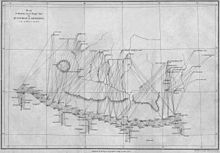Radhanath Sikdar
Radhanath Sikdar (also Sickdhar ; Bengali : রাধানাথ শিকদার Rādhānāth Śikdār ; * 1813 in Calcutta , British India ; † May 17, 1870 in Chandannagar ) was an Indian mathematician in the service of the Great Trigonometric Survey , who was the first to calculate the height of Mount Everest .
Live and act
Radhanath Sikdar graduated from Hindoo College, a predecessor of today's Presidency University .
When George Everest , the head of the Great Trigonometric Surveyor and Surveyor General of India , asked the college in 1831 about a mathematician with a good knowledge of spherical trigonometry , Radhanath Sikdar was recommended to him. Everest then hired him as a computor to calculate the heights and distances of the survey points from the observations of the geodesics when measuring the meridian arc - at a time when slide rules were not yet widespread.
Everest was impressed by his work and wrote about him:
“Hardy, energetic young man, ready to undergo any fatigue, and acquire a practical knowledge of all parts of his profession. There are a few of my instruments that he cannot manage; and none of my computations of which he is not thoroughly master. He can not only apply formulas but investigate them. "
“A tough, energetic young man, ready to take every effort and acquire practical knowledge of all areas of his profession. There are few of my instruments that he cannot handle, and none of my calculations that he is not thoroughly familiar with. He can not only apply formulas, but also understand their content. "
When Everest retired to England in 1843, Andrew Scott Waugh succeeded him and continued the triangulations , the longest of which was the series carried out along the eastern half of the Himalayas from 1845 to 1850 . Since the Nepalese government refused entry to their territory, the numerous peaks of the Himalayas, mostly unknown to the British, could only be sighted from distances of up to 200 km.
Radhanath Sikdar, who in the meantime had risen to Chief Computor , was responsible for calculating the exact position and height of the 79 peaks from these bearings. After extensive and complex calculations, in which sources of error such as light diffraction as well as temperature and air pressure fluctuations were taken into account as much as possible at the time, Sikdar came to the conclusion in 1852 that Peak XV at 29,002 feet (8,840 m) was the highest of the targeted peaks and therefore probably the highest mountain in the world.
Because of the uncertainties associated with the long distances, Andrew Waugh was reluctant to publish this news. Only after numerous further measurements and calculations did he inform the Royal Geographical Society in London in a letter dated March 1, 1856 that Peak XV was probably the highest peak in the world and that he had named it Mount Everest in honor of its predecessor . His Indian chief computor was not mentioned in the letter.
In addition to his duties as Chief Computor , Radhanath Sikdar was appointed head of the Calcutta Meteorological Observatory in 1852, where he introduced precise, regular observations. For shipping, he also installed a system of precise time information based on astronomical observations so that the chronometers on the ships could be adjusted.
Radhanath Sikdar, who had never married, retired in 1862 and died on May 17, 1870 at his home in Chandannagar on the banks of the Hugli, north of Calcutta.
Honors
Radhanath Sikdar became a member of the Royal Asiatic Society of Bengal in 1853 . In 2004 he was honored, together with Nain Singh , on a stamp pad of the Indian Post in memory of the Great Trigonometric Measurement.
Individual evidence
- ↑ Website of the Presidency University ( Memento of the original from September 7, 2012 in the Internet Archive ) Info: The archive link has been inserted automatically and has not yet been checked. Please check the original and archive link according to the instructions and then remove this notice.
- ↑ a b Soutik Biswas: The man who 'discovered' Everest on BBC News online, accessed September 10, 2012
- ↑ Andrew Waugh: Letter to the Royal Geographical Society dated March 1, 1856 . In: Proceedings of the Royal Geographical Society of London, no.IX , p. 345. Digitized on GoogleBooks
- ↑ Even today, a head of department or board member would normally not name the head of department responsible for the result in a comparable letter.
- ↑ a b Anjana Choudhury, RR Kelkar, AK Sen Sarma: Radhanath Sikdar: Through the Haze of Time and Neglect (PDF; 68 kB); Retrieved September 10, 2012
- ^ GTS stamps get ready to travel the world in The Times of India of June 29, 2004
- ^ Postage stamp pad with Radhanath Sikdar on a private website; Retrieved September 10, 2012
| personal data | |
|---|---|
| SURNAME | Sikdar, Radhanath |
| ALTERNATIVE NAMES | Sickdhar, Radhanath |
| BRIEF DESCRIPTION | Indian mathematician, was the first to calculate the height of Mount Everest |
| DATE OF BIRTH | 1813 |
| PLACE OF BIRTH | Calcutta |
| DATE OF DEATH | May 17, 1870 |
| Place of death | Chandannagar |

